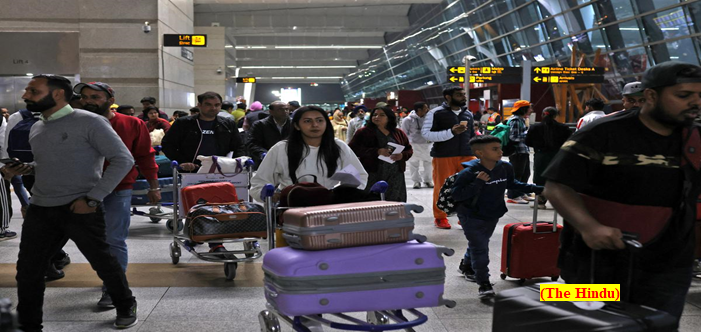How can mRNA vaccines help fight cancer? (GS Paper 3, Science and Tech)

Why in news?
- The results of a trial of an experimental cancer vaccine built on the mRNA (messenger ribonucleic acid) platform, made by Moderna and MSD (Merck&Co.), have shown promising results.
- Patients taking an immunotherapy drug Keytruda for advanced melanoma (a kind of skin cancer) were less likely to die or have the cancer recur, if they took the vaccine (mRNA-4157/V940) also.
What did the trial involve?
- It was a small study, involving 157 patients. The vaccine showed a 44% reduction in the risk of dying of cancer or having the cancer progress.
- As a personalised cancer vaccine, it is tailor-made for every patient. As a consequence, it is expected to be very expensive to make.
- The results too will have to be independently scrutinised by experts. But oncologists across the world have welcomed this as an exciting new opportunity in cancer care.
How does the vaccine work?
- The personalised cancer vaccine uses the same messenger-RNA technology that was used to produce the COVID vaccine. It allows the body’s immune system to seek and destroy cancerous cells, in this case melanoma, but with the hope that it could lead to new ways to fight other types of cancers too.
- RNA as a therapeutic was first promoted in 1989 after the development of a broadly applicable in vitro transfection technique. A couple of years later, mRNA was advocated as a vaccine platform.
Role of SARS-CoV-2 Vaccine:
- The refinement of the mRNA platform owes everything to COVID. The researchers have learned how to engineer stable forms of mRNA and deliver these molecules to the body through vaccines.
- The mRNA-based cancer treatment vaccines have reportedly been tested in small trials for nearly a decade, with some promising early results.
- As far as the SARS-CoV-2 vaccine was concerned, the mRNA included in the Pfizer-BioNTech and the Moderna vaccines instructs cells to produce a version of the “spike” protein that studs the surface of SARS-CoV-2. The immune system sees this spike protein as foreign and mobilises immune cells to produce antibodies to fight off the infection.
Personalised cancer vaccine:
- The personalised cancer vaccine works in concert with Merck’s Keytruda, to disable a protein called programmed death 1, or PD-1, that helps tumours to evade the immune system.
- To build the vaccine, researchers took samples of patients’ tumours and healthy tissue. After analysing the samples to decode their genetic sequence and isolate mutant proteins associated only with the cancer, that information was used to design a tailor-made cancer vaccine.
- When injected into a patient, the patient’s cells act as a manufacturing plant, producing perfect copies of the mutations for the immune system to recognise and destroy. Having been exposed to the mutations without the virus, the body learns to fight off the infection.
What does it mean for the future?
- Both approaches CAR-T cells and bi specific antibodies among newer cancer therapies, have already produced spectacular results in many cancers.
- While in CAR-T treatment, scientists take the immune systems cells out, engineer them to target a specific cancer and then put them back in the body to kill cancer cells, bispecific antibodies attach to immune system cells with one arm and cancer cells with the other, thereby bringing powerful immune system killer cells right next to the cancer cells. A few bispecific antibodies have been FDA-approved already.
- The possibility of using mRNA vaccine technology to fight cancer just got a boost. The idea of cancer vaccines has been around for a long time. But mRNA vaccine technology and personalisation of the vaccine that it allows provides a lot of optimism.
What is causing delays and chaos at Delhi airport?
(GS Paper 2, Governance)
Why in news?
- Over the past few weeks, there have been delays and long queues at the Indira Gandhi International Airport in New Delhi, prompting Union Minister of Civil Aviation to step in to initiate corrective measures.
- A parliamentary panel summoned the CEO of Delhi International Airport Limited (DIAL), and the Airports Authority of India has issued a notice to examine whether it failed to meet “service quality requirements.”

What are the reasons for over-crowding?
- Passengers have complained of long queues at entry gates, check-in counters as well as security lanes at the Indira Gandhi International Airport, with Terminal 3, built in 2010 to handle 3.4 crore passengers per annum, worst affected.
- So far December has witnessed a record number of air travellers since the COVID-19 outbreak with the highest number seen on December 11 when airlines carried 4.27 lakh domestic passengers.
- Delhi airport alone has seen 1,95,000 domestic and international passengers per day at all its three passenger terminal buildings.
- The number of flights and passengers at Delhi airport have grown exponentially, but its “infrastructure has frozen over time.”
Recommendations:
- Equipment like X-ray machines and door frame metal detectors are bought by the airport out of its capital expenditure, while the CISF provides personnel and their cost is met through the aviation security fee component of airfare paid by passengers.
- A decision was taken to install seven more X-ray machines and take the number of total security lanes to 20 from the current 13, which were found to be adequate only for 15 flights, while the airport saw up to 21 flights during peak hours.
- A parliamentary panel also met DIAL officials, and the Airports Authority of India has also issued a notice to DIAL.
What are the service quality requirements?
- The DIAL is supposed to submit a quarterly report on the “service quality requirements” spelt out in Schedule 3 of the Operations Management Development Agreement of 2006 under which certain functions at Delhi airport were privatised and given to the DIAL.
- The agreement specifies 13 different categories of services and the minimum time within which they should be available.
Service parameters:
- After the furore on overcrowding at Delhi Airport, the Airports Authority of India sent a notice to DIAL to examine whether it was failing to conform to the requirements.
- These include service parameters such as maximum queuing time; within two years of the deal, the airport has to ensure that for check-in the maximum waiting time is five minutes for business class and 20 minutes for economy.
- Similarly, for security check as well as customs, immigration and quarantine, as many as 95% of passengers should be cleared within 10 minutes.
- As far as baggage delivery is concerned, the first bag should arrive on the conveyor belt within 10 minutes, and the last bag should arrive within 30 minutes after the aircraft lands. The airport should also ensure wheelchairs for 100% of passengers who need them within five minutes.
- There are other service parameters too, which include time taken to find parking space, maximum waiting time for taxis, and response to customer complaints on phone.
- If the airport operator fails to provide these standards, it is liable to pay 0.5% of the monthly revenue for every month that the standards are below the laid down requirements.
Why has infrastructure not kept pace with the growth in demand?
- COVID-19 turned the clock back as passenger traffic suddenly dropped to 56% to 6.3 crore in calendar year 2020. However, passenger numbers have been growing steadily since March 2022 after the fear of Omicron faded away.
- Moreover, with Diwali and Dussehra festivals in October, resurgence in demand was established. But expansion plans at various airports were put on the backburner due to the impact of COVID-19 on revenue as well as unavailability of manpower and material.
- Delhi airport embarked on an expansion plan that would take its passenger handling capacity from 6.9 crore now to 10 crore by mid-2023, but it is already a year behind schedule.
Way Forward:
- Though this capacity will be breached in a couple of years, the National Capital Region will get its second airport in Noida International Airport in Jewar by 2024. The development of airports such as Mumbai and Chennai is also behind the growth curve.
- Though the government has granted in-principle approval to 21 greenfield airport projects, construction has only begun in nine of them.
Rajasthan Sanctuary gets protection against ESZ shrinking
(GS Paper 3, Environment)
Why in news?
- The famous Tal Chhapar blackbuck sanctuary in Rajasthan’s Churu district has received a protective cover against a proposed move of the State government to reduce the size of its eco-sensitive zone.
- The World Wildlife Fund for Nature (WWF) has also taken up a major project for the conservation of raptors in the sanctuary, spread in an area measuring 7.19 sq. km.

Background:
- The Rajasthan High Court has intervened through a suo motu public interest litigation to protect the sanctuary, taking cognisance of reports that its area was going to be reduced to three sq. km. under pressure from mine owners and stone crusher operators.
- The court recently ordered a “complete prohibition” on any action to reduce the wildlife sanctuary’s area.
Fauna:
- The sanctuary is host to about 4,000 blackbucks and other wild animals, over 40 species of raptors and more than 300 species of resident and migratory birds.
- The raptors, which include predators and scavengers, are on top of the food chain and control the populations of small mammals, birds and reptiles as well as insects.
Threats:
- Some exotic species of animals seemed to have been destroyed or relocated to other areas suitable for their survival, following an increase in human population around the sanctuary, and unplanned and rampant construction activities.
- The sanctuary earlier had a large population of desert foxes and similar burrowing animals, while the large colonies of the only herbivorous lizard, the spiny-tailed lizard, exist as the prey base for raptors.
- The issues confronting the sanctuary include hyper-aridity, grazing pressure, the invasive weed Prosopis juliflora, and salt mines in the vicinity. The sanctuary’s area is insufficient for its large blackbuck population.
Initiatives taken:
- The court struck down an order of September 30 renotifying a 2.7-km-long road, forming part of the Nokha-Sikar highway, passing through the sanctuary, and ordered its denotification keeping in view the presence of an alternative road existing adjacent to the protected forest area.
- The grassland for blackbucks was being continuously developed in the sanctuary and attempts were being made for the expansion of a prey base for the raptors.
- The forest authorities are also examining a proposal to develop the Jaswantgarh forest block in Nagaur district, situated at a short distance from Tal Chhapar, for the shifting of the excess population of blackbucks facing shortage of territory and grazing resources.
- The High Court has suggested the creation of a corridor for free movement of animals through an underpass across the railway line passing between the two areas.




